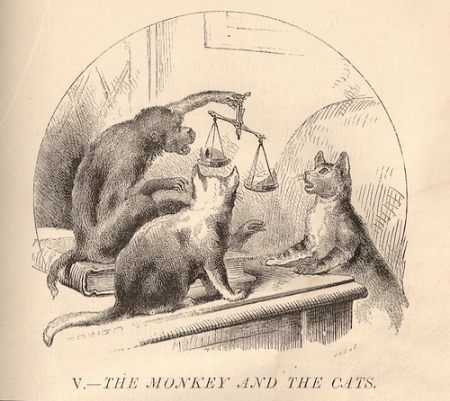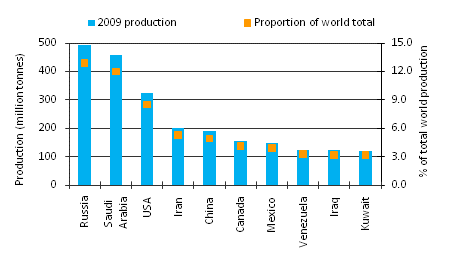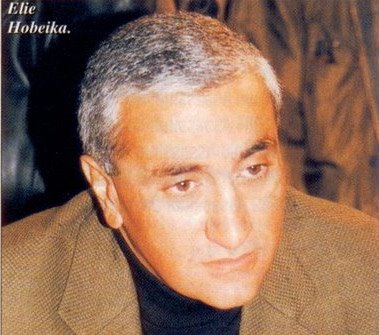
The Coming Oil Bottleneck, Eurasia and "F.U.D."...
FUD
There is an old, effective sales technique, attributed to IBM, which most multi-national corporations use in their sales training programs. It is called FUD – create Fear, Uncertainty andDoubt.
The IBM salesman, was taught how to create Fear, Uncertainty and Doubt in the buyer’s mind – against competitors. For the purposes of this post, it will be good idea to remember FUD.
Big Oil
The second important thing that is the key to this post is oil.
There is a great deal of concentration in the world oil industry: just ten companies control 68 percent of the world’s proven oil reserves. Nine of the ten biggest oil reserve holders are state-owned National Oil Companies (NOCs). Many of these were formerly private sector companies that were nationalized in the 1970s. Eight of the ten largest oil producers in the world are NOCs. The others are large integrated private sector energy companies. (via Energy Sector: Energy Sources: Petroleum Products and Crude Oil Prices: How World Oil Markets Work).

Fig.2 World's Top 10 Crude Oil Reserve Holders (Image Source - Natural Resources Canada| Data Source - Oil and Gas Journal, 2006). Click for larger image.
Oil trends
Saudi Arabia is expected to remain a top producer and exporter of oil in the foreseeable future. Canada is an interesting candidate. Based on current production, Canada ranks at No.6 but with the second largest proven reserves, Canada will be an important oil producer in the future. Russia is expected to remain a major producer-exporter.
US and China are interesting anomalies. Both are large oil producers, and also large importers of oil too. US-China are likely to remain large producer-importers for some more time.
Japan, Germany, South Korea, India, France will remain large importers.
Big Story – Caspian Oil
Most plans till early part of this decade involved Central Asian Oil and gas landing at Turkey for shipment to EU and USA. However, as the accompanying charts indicate, the real consumers for Central Asian gas and oil were going to be India and China. For instance US oil consumption between 1973-2010 has grown from 17 mpd to 19 mpd – with some peak and collapses.

Fig.3 US oil demand in the last 40 years has been stagnant - with a major collapse in 1980-1983. Click for a larger image.
Following the collapse of the Soviet Union, the world energy industry began drooling over the newly formed Central Asian republics and the Caspian Sea. Exploration quickly found what appeared to be enormous, untapped fields of oil and natural gas.
Prior to 1991, the only countries bordering the sea were the Soviet Union and Iran. These two countries were bound by the 1921 and 1940 bilateral treaties, which stated that Caspian resources were to be owned jointly. Since the dissolution of the Soviet Union and emergence of Kazakhstan, Turkmenistan and Azerbaijan, there have been numerous disputes about resources in the Caspian Sea. Disputes came to a head in July 2001, when Iranian gunboats confronted a British Petroleum research vessel and ordered it out of waters to which Iran lays claim.(via The Forging of ‘Pipelineistan’ – Oil, Gas Pipelines High Priority for US in Central Asian Military Campaigns).

Fig.4 The Tale of Two Pipelines. This map is indicative, as no final pipeline path has been sealed. There are variations on this exact direction of these pipelines. Click for a larger image.
How Pakistan fits in
Most of current oil reserves, crude production and refining capacities are tied to current demand. Hence, growth from India and China, can possibly be met from Central Asia only.
To meet the additional demand from India and China, without disrupting the market, means Central Asian oil – transported through transnational oil pipelines.
A direct deal between Iran and India, bypassing Central Asia, Pakistan, USA would jeopardise Big Oil interests. Many major US politicians like ex-Vice President DickCheney (with Halliburton), Condoleeza Rice (on Chevron board) are advisors to Big Oil and their Central Asian clients. Recently releases from Sarah Palin’s email records, ‘offer insights into … her decision to allow oil exploration in previously protected areas of Alaska’ and refer ‘intriguingly to “a meeting with staffer for Vice-President Cheney about gas pipeline and meetings with representatives of Alaska communities about Endangered Species Act”.’
There has been ongoing speculation that, more than the Pakistani State, both 9/11 and 26/11 are the handiwork of these oil interests – using mercenary jihadists. To push the Turkmenistan-Afghanistan-Pakistan-India deal – or stop the Iran-India pipeline deal, through Pakistan.
An undersea variant (see Fig.5) of the Iran-Pakistan-India pipeline is likely to more expensive. Hence Pakistan is likely to be the gatekeeper of oil and gas to India from Central Asia to India.
Starting with the army in Pakistan
‘Every country has an army, Pakistan’s army has a country’.
Instead of the one-party ‘dictatorship’ of China or a ‘two-party’ democracy in the West, there are many more Pakistan’ players – each jockeying for power, differently. In a very messy manner.
The various political factions in Pakistan are competing to assume power for a bargaining position with Big Oil – and India. This trade is expected to cross trillions, over the next few years. From this US$trillion-dollar opportunity, no political player in Pakistan, wants his cut to be diluted.
To this oil opportunity, add narcotics trade. The Golden Crescent (Iran, Afghanistan, Pakistan) and Golden Triangle (Thailand, Laos, Cambodia) are the largest producers of drugs – and expect massive returns on drug trade. This drug traffic is now passing through Pakistan. The Taliban have extensive experience with opium trade in Afghanistan.

Fig.5 To limit supply disruptions, India has proposed bypassing Pakistan completely. Image courtesy - energytribune.com. Click for larger image.
How anti-India is the aam-Pakistani?
There seems to be a belief in India that the ordinary Pakistani is anti-India. A sampling of some recent evidence, may make a case for alternative reading.
The most interesting was the Pakistaniinterest in Indian pauranik serials, especially in Pakistani-Punjab.
For another, we forget that Indian Muslims from India, Bangladesh and Pakistan did notvote for Pakistan or Jinnah. It was a small minority, of less than 5 lakhs who voted for the Muslim League, carefully selected by the British, which was designated as representative of Muslim interests, that voted for Pakistan. From the nearly 10 crore Muslims. A fact we would do well to remember.
The combative former foreign minister of Pakistan, Khurshid Mahmud Kasuri believes, that fundamentalistPakistani political ‘parties which gathered 50,000 people in Karachi over the blasphemy law recently wouldn’t gather 500 people if they declared war on India.’
I assume he knows.

Fig. 6 Two cats go to a monkey for justice and lose everything. Old Jataka tale. Can there be a 'honest' broker?
The US can never ever be an honest broker anywhere, it's a Zioconned dead-end....with utter corruption and criminality....
What will be US role, if India and Pakistan were to sit down and resolve their issues. It is in US interest for instance, to create false stereotypes of Pakistanis. Let us examine some common notions about Pakistan.
Note how many multiples of Americans die each year from guns, than in Pakistan.
Yet English media selectively emphasizes the Pakistani deaths. Is the world likely to allow NATO and US, a free run of Af-Pak region, if it was declared that Pakistan suffered from tribal violence – on a scale smaller than gangsta and ghetto violence in USA.
Why does China and US renew their loyalty and friendship vows with Pakistan every week?
Nuclear nightmare, anyone?
US and its many think tanks have raised global consciousness on the dangers of Pakistani nukes falling in terrorist hands. Pakistan however sees it differently.
Pakistan’s nuclear weapons are probably quite secure from terrorists — the nukes are its crown jewels. The army cares about them in ways that it does not about bin Laden’s whereabouts or fighting the Haqqani network.
The nuclear issue looks different from Pakistan. For most of the world, the question is, can terrorists steal the nuclear weapons? In Islamabad it’s, can the United States or India steal them?
Kamran Khan, on his nightly Geo TV talk show, asked provocatively: “We had the belief that our defense was impenetrable but look what has happened. Such a massive intrusion, and it went undetected. … What is the guarantee that our strategic assets and security installations are safe?”
He was not wondering whether the nuclear weapons are safe from terrorists but from the U.S. (viaOpinion: Beware decline in Pakistani relations – Toby Dalton and George Perkovich – POLITICO.com).
The Taliban spokesman to Wall Street Journal had an even more interesting take on this issue.
The Taliban has no plans to attack Pakistan’s nuclear arsenal, its spokesman declared; The Taliban’s spokesman, Ehsanullah Ehsan, dismissed those concerns Wednesday as America’s “excuse” to pressure Pakistan’s government into fighting the Taliban, who he portrayed as the country’s true protectors.
“Pakistan is the only Muslim nuclear-power state,” Mr. Ehsan said in a telephone interview, adding that the Taliban had no intention of changing that fact. The Taliban, after all, aim to take over Pakistan and its weapons.
Mr. Ehsan’s remarks appeared tailored to appeal to that increasingly nationalist mainstream, where conspiracy theories flourish about American, Indian and Israeli plots to deprive Pakistan of its atomic arsenal. Pakistan’s nuclear capability is cherished here as the guarantor of safety from India’s far larger conventional military.
The Pakistan Taliban, an offshoot of the Afghan insurgent movement, have repeatedly tried to win public support by presenting themselves as a defender of Pakistan, though their attacks have killed thousands of Pakistanis. (via Taliban Say They Won’t Target Pakistan’s Nuclear Arsenal – WSJ.com).
How important is Islam?
The other question that bothers Indians is the anti-India, anti-Hindu, fundamentalist, radical Islamic Pakistani mindset? Whew. Did I miss anything?
Which raid-and-ravage regime would like to proclaim that their objective is raid-and-ravage? 60 years after being expelled from India, 200 years of loot on a historic scale, does Britain admit that they were here to loot and plunder India? Does Spain admit that they went to the New World to loot and enslave? All these looters needed a fig leaf to cover their raid-and-ravage operations. Religion was their cover.
Why expect Islamic raiders-and-looters to be different?
Moreover, for a raid-and-ravage party, to mislead the victim is a logical tactic. To hide a loot-agenda under a religious garb makes eminent sense for the looter. Does it make sense for us to accept their religious declaration at face value? Like we can see in the many raid-and ravage attempts.
Timurlane did not come here to convert Indians to Islam. After the raid-and-ravage attacks, Mahmud of Ghazni, Mohammed Ghori, Timur Lame, Nadir Shah did not stay behind to control their ‘conquests’. So too, in modern Pakistan. Jinnah used religion to get a Pakistan for himself – though he himself was completely irreligious. The Pakistani Army also uses religion – but is itself irreligious.
Similarly the Spanish did not go to America for Christianity – but for gold. Simple. The Spanish king told his conquistadores, ‘Get gold, humanely if possible, but at all hazards, get gold.” (1511, King Ferdinand).
The East India Company made piously declarations on how ‘the banner of Christ should wave triumphant from one end of India to the other’. But the real reason for the East India Company was raid-and-ravage.
Anuraag Sanghi on June 9, 2011Like Alexander boasted of his conquest of India, many of these Islamic ‘conquerors’, also exaggerated.
Of course, Desert Bloc invented religion to create divisions, build a fifth column, in the ‘conquered’ people. Finally and initially, religion was the tool to use, many times the fig leaf too – but not the real cause for these rape-and-ravage adventures.
A 2ndlook at Pakistan
Pakistan is what Pakistan does.
Pakistan’s ability to keep its super-power allies on their toes is a remarkable diplomatic achievement. To remain a nuclear power, after near-universal condemnation and pressure reconfirms its diplomatic prowress. Pakistani leadership, from Jinnah onwards, have used the State and its institutions, for keeping a grip on power. That will continue.
What might change is the way power is shared. The Taliban may become a part of the Pakistani ruling class. How that will happen remains to be seen. A coup? Local elections, maybe. Electoral alliance? Pakistani power-equations are changing. How these equations work out, may surprise us.
Is India prepared? Ready?






